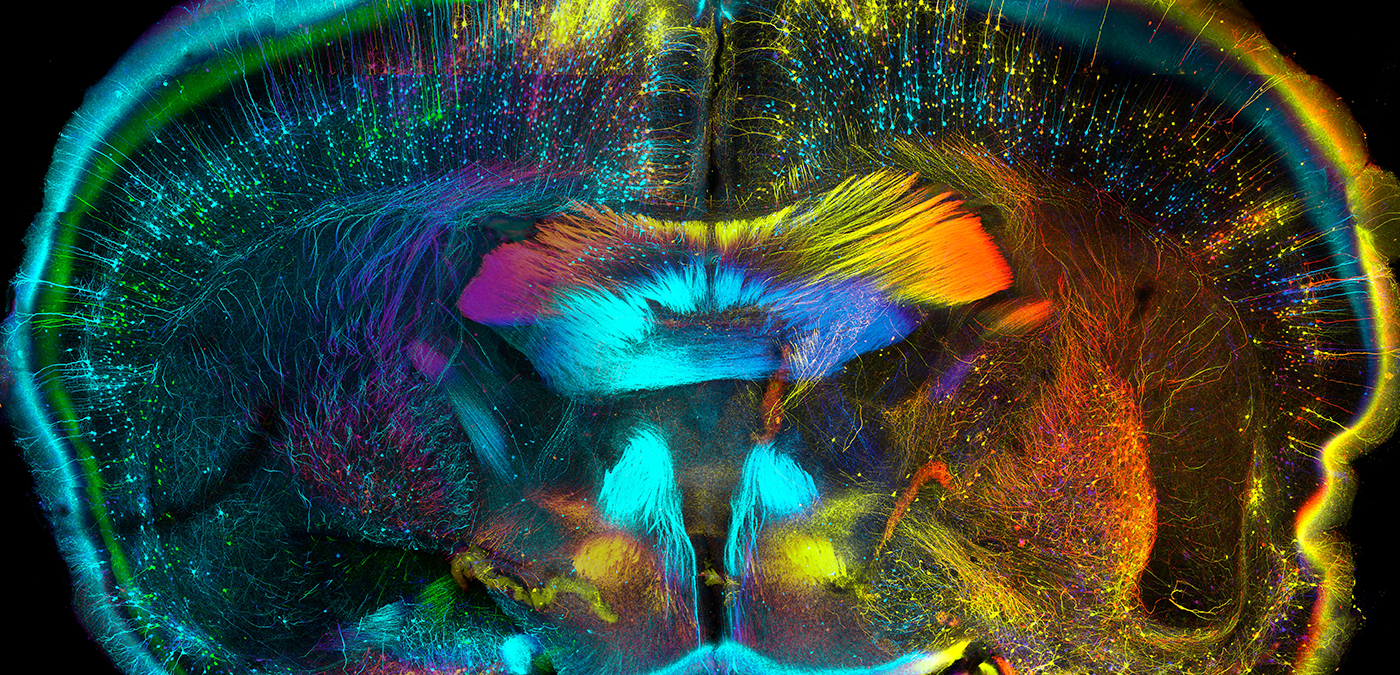
Mouse brain, coronal view. Credit: Luis de la Torre-Ubieta, Geschwind Laboratory, UCLA. CC BY-NC
Studying mouse brain development can give insights into human neurodevelopmental and psychiatric disorders, as well as help diagnose rare genetic conditions
On its own, the genome sequence of an organism doesn’t tell us much. It’s a long string of letters of code. But in that sequence are regions that mean something; areas of code that have specific functions in our cells and bodies. Finding those sequences and determining their function is the goal of thousands of researchers world-wide. Much is known – the locations of all the genes within a genome sequence have been determined in many organisms, including humans. Regions of the genome that regulate a gene’s activity have also been described. But how do researchers uncover what those genes do? It isn’t yet possible to predict a function from the gene sequence alone.
One way is to study mice. They have similar genes to humans; we are both mammals with the same organs and same basic structure. Finding out what genes do in mice can give researchers ideas about human health and disease.
Image credit: Wellcome Sanger Institute, Genome Research Limited
Mouse Genetics
The Sanger Institute Mouse Genetics Project is part of the international effort to discover the function of every gene in the mouse. Whilst the Sanger Institute has expertise in mouse genetics, the team reached out to other specialists when it came to studying the effects genes have on different organs.
Valerie Vancollie, Advanced Research Assistant at the Sanger Institute, talks about their latest work and discoveries on the genetics of brain development. Their 11-year project was recently published in Nature Communications.
“The intention was to find experts in a particular area who could examine various organs in a high-throughput pipeline. At its peak, we were looking at the effects of 200 genes a year.”
In Professor Binnaz Yalcin and her team at the Institut de Génétique et de Biologie Moléculaire et Cellulaire in France, they found brain anatomy specialists.
“Professor Yalcin and her team set up a screen to examine the mouse brains we sent them. Instead of using a qualitative approach, which relies on someone eyeballing samples of brain tissue to determine if there are differences between them, they decided to use a systematic, measured approach,” says Valerie.
This meant that each brain sample they looked at was treated in a similar way. This allowed for comparisons even when different people analysed the samples. 118 different measurements were taken, including the size of the ventricles - fluid-filled cavities in the brain, the number of cells in specific brain areas like the corpus callosum - which connects the two halves of the brain, or the total brain area.
“The fact we did not target specific brain areas for study, but rather measured as many as we could, means the abnormalities we found cover a wide range of areas. These include smaller or larger brains - micro- or macrocephaly, missing corpus callosum, and alterations to both very specific parts of the brain, or to large swathes of it.”
Coronal striatum section of the mouse brain. Image courtesy of Professor Binnaz Yalcin, the Institut de Génétique et de Biologie Moléculaire et Cellulaire
Of Mice & Men
The team found 198 genes which caused abnormalities in the mouse brain[1]. The vast majority had not previously been associated with brain development. Only 17 per cent of those are currently known to have a similar effect in humans. This leaves a list of 160 genes which caused some form of brain abnormality in the mice, and could potentially affect humans.
“While not every gene will have the same effect in humans, three of the genes which were unknown in humans when we discovered them have since been found to affect people too - Kptn, Donson and Aff3. This shows us that this list of genes provide a fantastic starting point for further studies,” says Valerie.
Gene identification for neuroanatomical characteristics. A) One hundred and eighteen brain parameters are grouped into six categories (brain size, cortex, subcortex, commissures, ventricles and cerebellum/pons) at the indicated positions. B) Mouse genes whose disruptions caused a neuroanatomical defect are positioned on each category and color-coded. Red font corresponds to decrease in structure size, green to increase, yellow to both. Image credit: Nature Communications doi:10.1038/s41467-019-11431-2
“Beyond science, this study was also a human adventure since several dozens of people came to our laboratory, from different horizons of life, different countries, to manually annotate mouse brain images with such enthusiasm.”
Dr Stephan Collins, Institut de Génétique et de Biologie Moléculaire et Cellulaire, France
Understanding human disorders
Professor Binnaz Yalcin said: “This study provides a wealth of novel knowledge about which genes control the size and the shape of the brain, and a foundation on which neurobiologists can build to further study how exactly these genes control the brain anatomy.”
The team have shown that their findings are relevant to people and can give insights into neurodevelopmental and psychiatric disorders. Their findings could also help diagnose rare genetic conditions.
“I have no doubt that this resource will help medical geneticists working on ultra-rare human neurodevelopmental disorders who sometimes struggle to determine the genetic mutation responsible for a disease, when for example there is only one patient world-wide,” says Binnaz.
“This study represents an enormous effort and is a tribute to the remarkable work of the people involved.”
Links
Research Paper: Large-scale neuroanatomical study uncovers 198 gene associations in mouse brain morphogenesis. Nature Communications (2019); 10: Article number: 3465
Project Introduction Paper: Genome-wide Generation and Systematic Phenotyping of Knockout Mice Reveals New Roles for Many Genes. Cell (2013); 154: 452-464.
International Research Collaboration: International Mouse Phenotyping Consortium (IMPC)
Reference
[1] Research Paper: Large-scale neuroanatomical study uncovers 198 gene associations in mouse brain morphogenesis. Nature Communications (2019); 10: Article number: 3465









